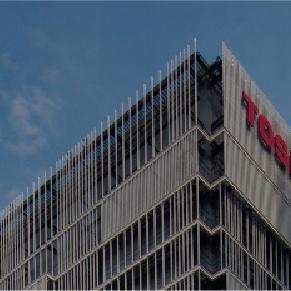Technology to separate four elements from high-level radioactive waste
- Reduction of long-lived fission products (LLFP) and resource recycling -NEWS RELEASE
Nuclear Power
R & D / Technology
Toshiba Energy Systems & Solutions Corporation
Japan Science Technology Agency(JST)
Director General for Science, Technology and Innovation Policy, Cabinet Office
Points
・Proposed a chemical separation system to isolate palladium (Pd), selenium (Se), cesium (Cs) and zirconium (Zr) individually out of high-level radioactive waste containing long-lived fission products (LLFP).
・Combined with odd/even separation technology and transmutation methods developed in advance by this research program, this method will advance the technology to reduce long-lived radionuclides.
・The research team will continue to pursue practical techniques to reduce and recycle the high-level radioactive waste from nuclear power plants.
Toshiba Energy Systems & Solutions Corporation proposed a chemical separation system to isolate four elements into metals from high-level radioactive waste1) containing long-lived fission products (LLFP)2). This system consists of chemical separation techniques elaborated to minimize the secondary radioactive waste.
This research was conducted under the ImPACT Program led by the Council for Science, Technology and Innovation, Cabinet Office, for the “Reduction and Resource Recycling of High-level Radioactive Wastes through Nuclear Transmutation3)”(Program Manager: Reiko Fujita, PhD). In this ImPACT Program led by Fujita, methods of reducing LLFP and recycling resources from radioactive waste are being investigated. The nuclear transmutation methods can convert LLFP into stable, short-lived radionuclides. Ecological technologies, furthermore, will be needed to reuse rare metals and other resources included in the recovered products.
High-level radioactive wastes are caused by processing spent nuclear fuel from nuclear plants, and they contain palladium (Pd), selenium (Se), cesium (Cs), zirconium (Zr), and other LLFP, which have a half-life of around one million years.
These elements have different chemical properties, which accordingly require the combination of several different separation techniques. It has been difficult to move forward with the LLFP separation techniques, because those separation techniques cause a high diffusion of radioactivity and produce large amounts of secondary radioactive waste.
The research team proposed a system for recovering LLFP;Pd, Se, Cs and Zr, directly from high-level radioactive waste using electrolytic deposition4), adsorption5) and solvent extraction6).
This chemical separation system does not require changing liquid acidity in each process, which enables to minimize the secondary radioactive waste.
The research team will continue to pursue practical techniques to reduce and recycle the high-level radioactive waste from nuclear power plants.
The outcome of this research will be presented at the 15th NEA (the OECD Nuclear Energy Agency) Information Exchange Meeting on Actinide and Fission Product Partitioning and Transmutation (Manchester, UK, Sep.30 - Oct.3 2018) and in Solvent Extraction and Research Development, Japan, 25(2), 2018. Patents are applied; “Recovery of long-lived fission products from high-level radioactive waste”(Japanese patent application number: 2016-207117, application date: 2016/10/21) and “Separation of metals”(Japanese patent application number:2017-034812, application date: 2017/02/27).
Technical terms:
1) high-level radioactive waste
High-level radioactive waste is waste containing very highly radioactive nuclides and needs to be kept cool for many years before it can be disposed. Usually, it is in the form of nitric acid solution after spent fuel is partitioned from nuclear plants.
2) long-lived fission products(LLFP)
Fission products are nuclides caused by the fission of U-235 in nuclear reactors, for example, Sr-90 and Cs-137. Those that are long-lived are called long-lived fission products, or “LLFP.” High-level radioactive waste contains products such as 79Se(half-life: 2.95×105 years), 93Zr (1.53×106 years), 99Tc (2.11×105 years), 107Pd (6.5×106 years), 126Sn (1.0×105 years), 129I (1.57×107 years), and 135Cs (2.3×106 years).
3) nuclear transmutation
Nuclear transmutation is the process of changing LLFP to another nuclide, such as short-lived fission products or stable fission products.
4) electrolytic deposition
Electrolytic deposition is the deposition of metals on electrodes from liquids using electricity with two electrodes in the liquids. In this process, Pd and Se are deposited from high-level radioactive waste.
5) adsorption
Adsorption is the adhesion of atoms, ions, or molecules from gas, liquid, or a dissolved solid to a surface. In this process, Cs is adsorbed from high-level radioactive waste.
6) Solvent extraction
Solvent extraction is a method of separating metal complexes, based on their relative solubility in two different immiscible liquids: high-level radioactive waste and an organic solvent. In this process, Zr is extracted from high-level radioactive waste.
Titles of related papers
Title 1: Reduction and Resource Recycling of High-level Liquid Radioactive Wastes Through Nuclear Transmutation —Electrolytic deposition based process to recover long-lived radionuclides of Pd, Zr, Se and Cs from simulated high-level radioactive wastes—
Authors: Y. Takahashi, M. Kaneko, Y. Yamashita, T. Omori, K. Asano, Y. Sasaki, K. Ito, and S. Suzuki.
Journals: Proceedings of International Nuclear Fuel Cycle Conference(Global2017), Sep. 24-29, 2017, Seoul, Korea; Paper Number: EA-257.
Title 2: Extraction and separation of Se, Zr, Pd, and Cs including long-lived radionuclides
Authors: Y. Sasaki, K. Morita, S. Suzuki, H. Shiwaku, K. Ito, Y. Takahashi, and M. Kaneko.
Journals: Solvent Extr. Res. Dev. Jpn.
For furthermore information about Nuclear Power Business, please check here.
Information in the news release, including product prices and specifications, content of services and contact information, is current on the date of the news release , but is subject to change without prior notice.





